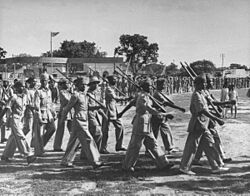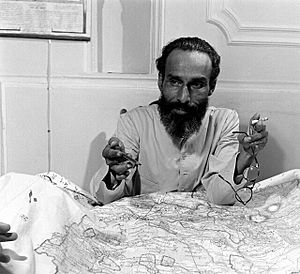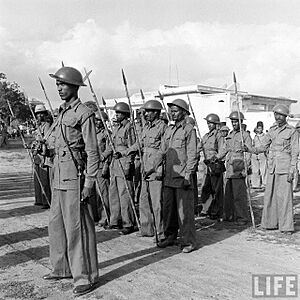Razakars (Hyderabad) facts for kids

Razakar units being trained
|
|
| Formation | 1938 |
|---|---|
| Founder | Bahadur Yar Jung |
| Dissolved | 1948 |
| Type | Paramilitary |
| Purpose | Supporting Osman Ali Khan, Asaf Jah VII in resisting the integration of Hyderabad with India |
| Headquarters | Hyderabad |
|
Region served
|
Hyderabad State |
| Leader | Bahadur Yar Jung Qasim Razvi |
| Affiliations | Majlis-e-Ittehadul Muslimeen |
The Razakars were an armed volunteer group, similar to a private army, connected to a political party called the Majlis-e-Ittehadul Muslimeen (MIM). This was all happening in Hyderabad, which was a large princely state in India before the country's independence.
The Razakars were formed in 1938. Their main goal was to keep the Muslim ruler, called the Nizam, in power. They strongly opposed Hyderabad becoming part of India. The group grew much larger under the leadership of Qasim Razvi around 1947, a time when India was being divided.
The government of India saw the Razakars as a threat. The Nizam's refusal to break up the group was one of the main reasons India launched a military mission called Operation Polo. This operation led to Hyderabad becoming part of India. The Razakars fought against the Indian Army but were defeated. After their defeat, the Nizam surrendered and the Razakars were officially ended.
During their time, the Razakars were known for committing terrible acts of violence. They attacked many Hindu people, who made up the majority of Hyderabad's population and mostly wanted to join India. They also targeted people who were part of a peasant movement called the Telangana Rebellion.
History of the Razakars


When the British left India in 1947, the many princely states had a choice. They could join the new country of India, join Pakistan, or become fully independent. By 1948, almost all states had joined either India or Pakistan.
Hyderabad was a big exception. Its ruler, Osman Ali Khan, Asaf Jah VII, was a Muslim, but most of the people he ruled were Hindu. He wanted Hyderabad to be an independent country. To help him achieve this, he relied on the Razakars. He signed a "standstill agreement" with India, which meant that for a while, things would stay as they were. However, most of the people in Hyderabad wanted to join India, and they resisted the Nizam's plan.
The MIM political party, which the Razakars belonged to, was founded in 1926. It became very powerful and wanted Hyderabad to be a Muslim state. The Razakars acted as their armed force. Their leader, Kasim Razvi, argued that Hyderabad was a Muslim state because it had been conquered by Muslims in the past.
The Razakars became very powerful and started to misuse their power. They used violence to stop anyone who supported joining India. They attacked villages and scared the Hindu population, causing many people to run away and hide. They even attacked other Muslims, like the journalist Shoebullah Khan, who wrote in favor of joining India.
Annexation after Operation Polo
The Indian government grew concerned about the violence and instability in Hyderabad. Sardar Vallabhbhai Patel, India's Home Affairs Minister, decided to take action. He launched a "police action" called Operation Polo to make Hyderabad join India.
The Indian Army, led by Major General J. N. Chaudhuri, entered Hyderabad from five different directions. The Razakars tried to fight back, but they were no match for the Indian army. They surrendered on September 18, 1948. The Nizam's prime minister and the Razakar leader, Kasim Razvi, were arrested.
A few days later, the Nizam officially announced that Hyderabad would merge with the Indian Union. Major General Chaudhuri became the military governor of Hyderabad for about a year. Later, Hyderabad became a state within India, and the Nizam was given the new title of "Rajpramukh" (Governor).
A special report, known as the Pandit Sunderlal Committee Report, was created after the conflict. It estimated that tens of thousands of people lost their lives in the violence that happened during and after the operation.
Disbandment of the Group
After Hyderabad merged with India, the Razakars were broken up. The MIM political party was also banned for a time. It was allowed to start again in 1957 with a new name, All India MIM (AIMIM), and new leadership.
Qasim Rizvi, the former leader of the Razakars, was sent to prison in India for nearly ten years. After he was released, he was allowed to move to Pakistan.
See also
- Muslim National Guard
- Razakars (East Pakistan)
- Hyderabad State Forces
- Kasim Razvi
- Mallikarjun Kharge, the current president of the Indian National Congress, lost his mother and sister in a fire set off by the Razakars while he himself had a narrow escape at the age of 7

